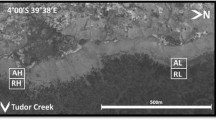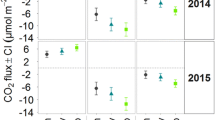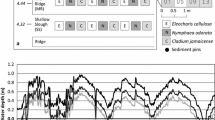Summary
Lacunal allocation as the fraction of the total cross sectional area of leaves, stem bases, rhizomes, and roots was determined in both tall and short growth forms of Spartina alterniflora collected from natural monospecific stands. The results indicate that in both growth forms lacunal allocation is greater in stem bases and rhizomes than in leaves and roots and that tall form plants allocate more of their stem and rhizome to lacunae than short form plants.
Measurements made in natural stands of Spartina alterniflora suggest that total lacunal area of the stem base increases with increasing stem diameter and that stem diameter increases with increasing plant height and above-ground biomass. However, the fraction of cross section allocated to lacunae was relatively constant and increased only with the formation of a central lacuna.
Experimental manipulations of surface and subsurface water exchange were carried out to test the influence of flooding regime on aerenchyma formation. No significant differences in lacunal allocation were detected between plants grown in flooded (reduced) and drained (oxidized) sediments in either laboratory or field experiments. While aerenchyma formation in Spartina alterniflora may be an adaptation to soil waterlogging/anoxia, our results suggest that lacunal formation is maximized as a normal part of development with allocation constrained structurally by the size of plants in highly organic New England and Mid-Atlantic marshes.
The cross sectional area of aerenchyma for gas transport was found to be related to the growth of Spartina alterniflora with stands of short form Spartina alterniflora exhibiting a lower specific gas transport capacity (lacunal area per unit below ground biomass) than tall form plants despite having a similar below-ground biomass supported by a 10 fold higher culm density. The increased specific gas transport capacity in tall vs. short plants may provide a new mechanism to explain the better aeration, higher nutrient uptake rates and lower frequency of anaerobic respiration in roots of tall vs. short Spartina alterniflora.
Similar content being viewed by others
References
Bennett HS, Wyrick AD, Lee SW, McNeil JH (1976) Science and art in preparing tissues embedded in plastic for light microscopy, with special reference to glycol methacrylate, glass knives and simple stains. Stain Technol 51:71–96
Berner RA (1963) Electrode studies of hydrogen sulfide in marine sediments. Geochim Cosmochim Acta 27:563–575
Burdick DM, Mendelssohn IA (1990) Relationship between anatomical and metabolic responses to soil waterlogging in the coastal gass Spartina patens. J Exp Bot 41:223–228
Carlson PR Jr, Forrest J (1982) Uptake of dissolved sulfide by Spartina alterniflora: evidence from natural sulfur isotope abundance ratios. Science 216:633–635
Howes BL, Dacey JWH, King GM (1984) Carbon flow through oxygen and sulfate reduction pathways in salt marsh sediments. Limnol Oceanogr 29:1037–1051
Howes BL, Dacey JWH, Goehringer DD (1986) Factors controlling the growth form of Spartina alterniflora: Feedbacks between above-ground production, sediment oxidation, nitrogen and salinity. J Ecol 74:881–898
Howes BL, Howarth RW, Teal JM, Valiela I (1981) Oxidation-reduction potentials in a salt marsh: Spatial patterns and interactions with primary production. Limnol Oceanogr 26:350–360
Howes BL, Teal JM (submitted) Oxygen loss from Spartina alterniflora and its relationship to rhizosphere waterlogging.
Jackson MB, Fenning TM, Jenkins W (1985) Aerenchyma (gas-space) formation in adventitious roots of (Oriza sativa) is not controlled by ethylene or small partial pressures of oxygen. J Exp Bot 36:1566–1572
Kawase M (1981) Effect of ethylene on aerenchyma development Am J Bot 68:651–658
Koch MS, Mendelssohn IA (1989) Sulphide as a soil phytotoxin: Differential responses in low marsh species. J Ecol 77:565–578
Mendelssohn IA, McKee KL, Patrick WH (1981) Oxygen deficiency in Spartina alterniflora roots: Metabolic adaptation to anoxia. Science 214:439–441
Mitsui S (1965) Dynamic aspects of nutrient uptake. In: International Rice Research Institute (ed) Proc Symp Mineral Nutrition of the Rice Plant. Johns Hopkins Press, New York, pp 53–62
Moog PR, Janiesch P (1990) Root growth and morphology of Carex species as influenced by oxygen deficiency. Funct Ecol 4:201–208
Morris JT (1980) The nitrogen uptake kinetics of Spartina alterniflora in culture. Ecology 61:1114–1121
Morris JT, Dacey JWH (1984) Effects of O2 on ammonium uptake and root respiration by Spartina alterniflora. Am J Bot 71:979–985
Seliskar DM (1988) Waterlogging stress and ethylene production in the dune slack plant, Scirpus americanus. J Exp Bot 39:1639–1648
Strakosch K (1992) The effects of soil water movement on the productivity and elemental composition of a New Jersey salt marsh population of short form Spartina alterniflora. M. S. Thesis Rutgers, The State University of New Jersey
Sullivan MJ, Daiber FC (1974) Responses in production of cordgrass Spartina alterniflora, to inorganic nitrogen and phosphorus fertilizer. Ches Sci 15:121–123
Teal JM, Kanwisher JW (1961) Gas exchange in a Georgia salt marsh. Limnol Oceanogr 6:388–399
Teal JM, Kanwisher JW (1966) Gas transport in the marsh grass, Spartina alterniflora. J Exp Bot 51:355–361
Valiela I, Teal JM (1974) Nutrient limitation in salt marsh vegetation. In: Reimold RJ, Queen WH (eds) Ecology of Halophytes. Academic Press, London New York, pp 547–563
Valiela I, Teal JM, Deuser WG (1978) The nature of growth forms in the salt marsh grass Spartina alterniflora. Am Nat 112:461–470
Vlamis J, Davis AR (1944) Effects of oxygen tension on certain physiological responses of rice, barley, and tomato. Plant Physiol 19:33–51
Williams WT, Barber DA (1961) The functional significance of aerenchyma in plants. SEB Symp 15:132–144
Author information
Authors and Affiliations
Rights and permissions
About this article
Cite this article
Arenovski, A.L., Howes, B.L. Lacunal allocation and gas transport capacity in the salt marsh grass Spartina alterniflora . Oecologia 90, 316–322 (1992). https://doi.org/10.1007/BF00317687
Received:
Accepted:
Issue Date:
DOI: https://doi.org/10.1007/BF00317687




